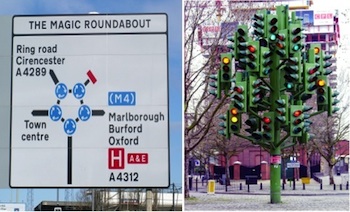European Marketing – Driving (Miss, Fräulein, Mademoiselle, Señorita, Signorina, Senhorita, Mejuffrouw, Fröken, Frøken, Neiti) Daisy

In the first blog of this series, I examined four categories – market, procedural, demand generation and cultural variations – that together make the job of a European marketer different from that of a North American marketer. I intentionally use the term “different” rather than “harder,” because having started my career in the U.S., I know each has its own nuances. A good analogy is driving in a European country vs. a North American country. Both drivers require skill and expertise, but drivers in the U.K. have more experience navigating complex roundabouts while drivers in the U.S. have more experience navigating large traffic light intersections.
In the first category, market variations, I examine how things like market size, buyer persona, competitive landscape, regulatory, channel partner and economic differences shape how European marketers think about and plan their activities.
Market Variations
Market size differences. From the word go, European marketers must contend with the reality that the size and strategic importance of target segments can vary dramatically from one European country to another. For example, Germany is a bigger market than The Netherlands, but the large number of global companies with regional headquarters in The Netherlands makes it a must for marketers targeting large enterprises. Before making campaign investment decisions, marketers must spend time researching where opportunity for pipeline generation is the greatest. Central repositories for this information are not freely available, so marketers end up spending a lot of time scouring the Web, hunting for information on each European country.
Buyer persona differences. Even when selling to the same buying centers and personas as their North American peers, European marketers must deal with multiple buyer persona variations in job titles, scopes of responsibility and empowerment levels. A director in one country may have significantly more power than a director in another. Watering holes also vary by country as many European buyers favor local portals, associations and events where they are more comfortable seeking advice. And while business challenges are similar, buyer constraints may be more complex in European countries due to local regulations and economic conditions. This results in longer planning horizons and slower sales cycles that drive different pressure points for demand generation.
Competitive landscape differences. It takes time and energy to gain an in-depth understanding of each of your competitors. In Europe, marketers must understand a significant number of strong national competitors per country in addition to global competitors. Analyzing national competitors often falls to local marketers, because global product managers don’t have the bandwidth or the local knowledge required. Understanding the competitive landscape per country is imperative as this insight helps shape the messaging and offer localization per market.
Regulatory differences. Financial, healthcare, public sector, employment, duty of care and data privacy regulations vary by European country. Marketers seeking to deploy industry focused campaigns across Europe must become quasi-experts in these regulations. Multi-country campaigns must also adhere to each market’s marketing regulations. Tactics (e.g. cold calling that are acceptable in one country may be considered a fineable offense in another.
Channel partner differences. Global sellers frequently sign partnership agreements with global distributors, hoping to leverage that relationship across multiple countries. Unfortunately, many of these organizations have stand-alone reporting structures and sales targets per country, making it impossible to successfully execute a universal channel marketing strategy. To gain traction, channel marketing plans must be tailored to the needs of each market. Frequently sellers also partner with multiple smaller national distributors per European country. Global partnerships may be supported through a global business development function, but local marketers are typically asked to support local partners alongside their direct sales force in the misguided belief that these partners require little support.
Economic climate differences. Staying up to speed on the state of each European economy can be a full-time task. Although marketers are not expected to be part-time economists, many try to leverage current events where possible to offer timely and relevant messaging per market. Doing this across a number of countries is challenging and often leads to criticism from sales that smaller local competitors with smaller marketing budgets appear to do a better job of grabbing the headlines and the attention of prospects.
These differences are part of a European marketer’s daily fare. In calling these out, I am not asking for a vote of sympathy but merely pointing out the juggling act that is required. In subsequent blogs, I will discuss how this constant juggling drives procedural variations in how European marketers plan, budget and manage their activities. In the meantime, have your say by taking part in the survey below!